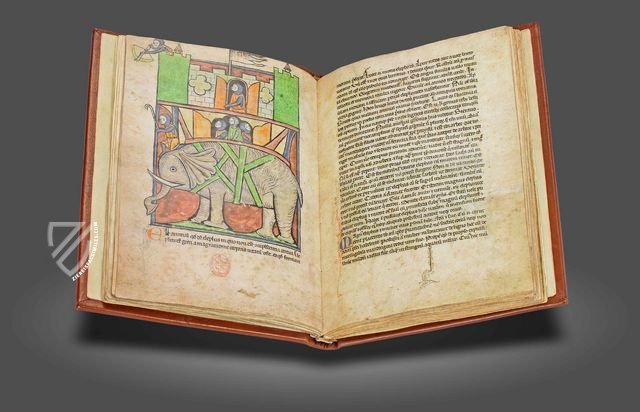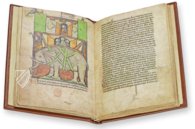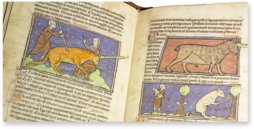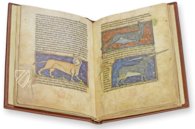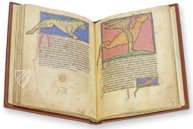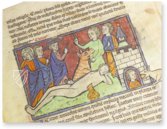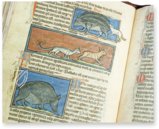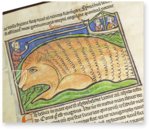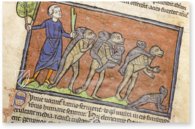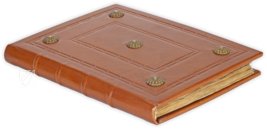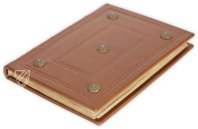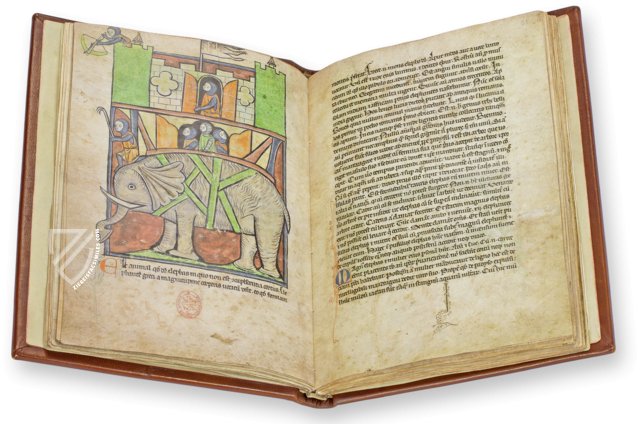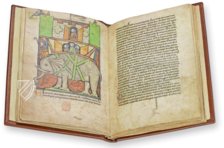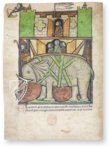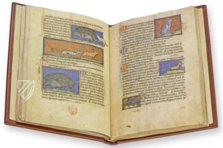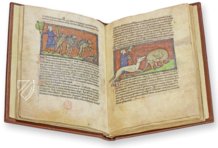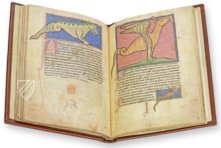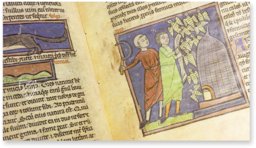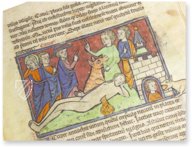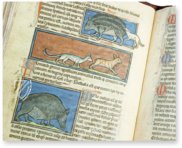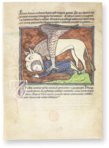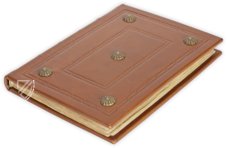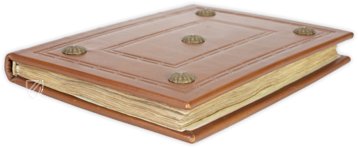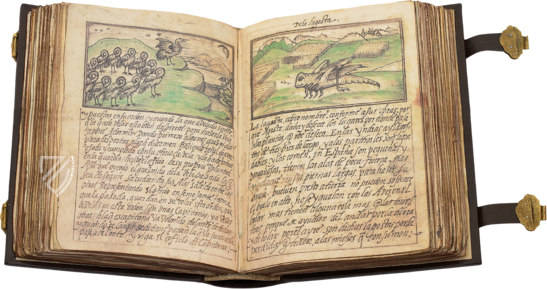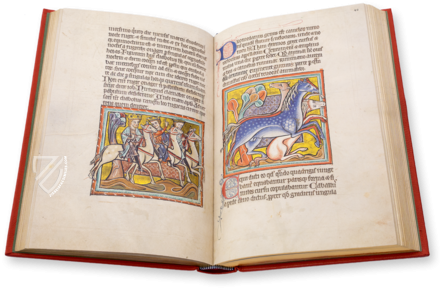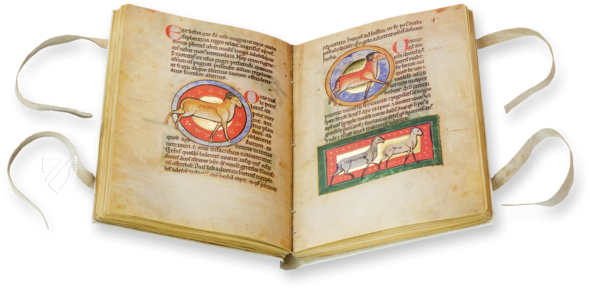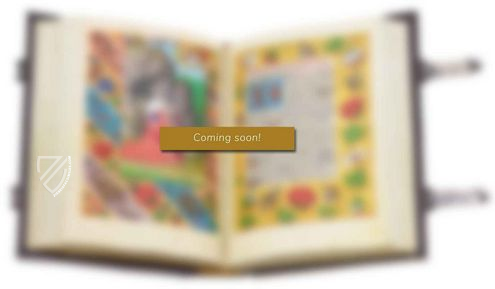Westminster Abbey Bestiary
(3,000€ - 7,000€)
The library of London’s significant Westminster Abbey contains a grandiose jewel of medieval illumination: the famous Westminster Abbey Bestiary. Emerging at the end of the 13th century, the Westminster Abbey Bestiary is counted among the most beautiful of its kind. Wonderfully designed, exceedingly entertaining miniatures illustrate the numerous descriptions of animals and creatures both real and fantastical. The moral-didactic agenda of this manuscript fades into the background in the face of its grandiose furnishings, but can be traced in the Latin-French text nonetheless.
Westminster Abbey Bestiary
The library of London’s significant Westminster Abbey contains a grandiose jewel of medieval illumination: the famous Westminster Abbey Bestiary. Emerging at the end of the 13th century, the Westminster Abbey Bestiary is counted among the most beautiful of its kind. Wonderfully designed, exceedingly entertaining miniatures illustrate the numerous descriptions of animals and creatures both real and fantastical. The moral-didactic agenda of this manuscript fades into the background in the face of its grandiose furnishings, but can be traced in the Latin-French text nonetheless.
A Fantastical Encyclopedia of the Animal Kingdom
Bestiaries are collections of short description of all kinds of animals and fantastical creatures, which are supplemented with a moralizing Christian explanation. The origins of the widely disseminated bestiary go back to the so-called Physiologus, a natural history document from the 2nd century. This was repeatedly spread and appended over the centuries, e.g. the Etymologiae by Isidor de Sevilla** from the 7th century, and has been translated into numerous languages. Since the 12th century, this simultaneously educational and entertaining genre has been widely disseminated and was particularly popular in England and northern France. The illustrations accompanying the text of the descriptions of nature and fantasy offered the illuminators the outstanding opportunity to present all of their ability. Thus were they able to fare into the most realistic depictions of the animal kingdom possible, while also being able to give their imaginations free reign in the depiction of three-headed monsters and similarly curious creatures.
Simple Images with Impressive Content
The bestiary, which resides today in the Library of the English Coronation Church, probably originated in York ca. 1275–90. It collects 164 fascinating miniatures on its 130 pages. Sometimes these take up an entire page, at others they are smaller and can be found on a page in greater numbers. Gorgeous, loving depictions of animals populate the pages of the manuscript. Sometimes these are very realistic, at others they are exceedingly fantastical. Whether a huge elephant, a mythical unicorn, a horde of apes, or a flock of birds that have been released from their cage: the artist of the miniatures created images of grandiose impact. These appear at first glance to be very simple and first unfold their effect upon closer inspection. Always depicted in slender frames before a monochromatic background, the miniatures enchant not only through their curious and realistic representations, but also with their luminous colorfulness. The back text is riddled with colorful initials and small ornamental elements in many places.
An Entertaining Picture Book for ‘Grownups’
The pictorial and symbolic presentation of the animal kingdom had no requirement for natural-scientific correctness, according to the perception of the Middle Ages. The spell of the bestiary does not come from its natural and theological design, but rather comes from the artfully and lovingly painted miniatures that supplement the text. These pictures of a huge whale, a fat porcupine, a three-headed dog, or a bizarre human-like creature fascinated the medieval beholder as much as the modern. The specimen from Westminster offers this fascination in exceptional artistic quality. It is not without reason that the Westminster Abbey Bestiary is considered to be one of the most beautiful specimens of this fascinating genre of medieval illumination.
Codicology
- Alternative Titles
- Bestiario de Westminster
Bestiarium aus Westminster - Size / Format
- 130 pages / 22.0 × 16.0 cm
- Origin
- United Kingdom
- Date
- Around 1275–1290
- Epochs
- Style
- Genre
- Illustrations
- 164 miniatures
- Artist / School
- Isidore of Seville (author)
Westminster Abbey Bestiary
A Griffin Devouring a Man
A pious man is shown meeting his death as he is eaten by a griffin, a lion-eagle hybrid creature that was also a popular symbol in medieval heraldry because it united the king of the beasts of the field with the king of the birds in the sky. They have been depicted as the guardians of great treasures since antiquity and were regarded as a Christian symbol of divine power in medieval Europe. According to medieval legend, they mated for life and their claws and feathers had medicinal properties.
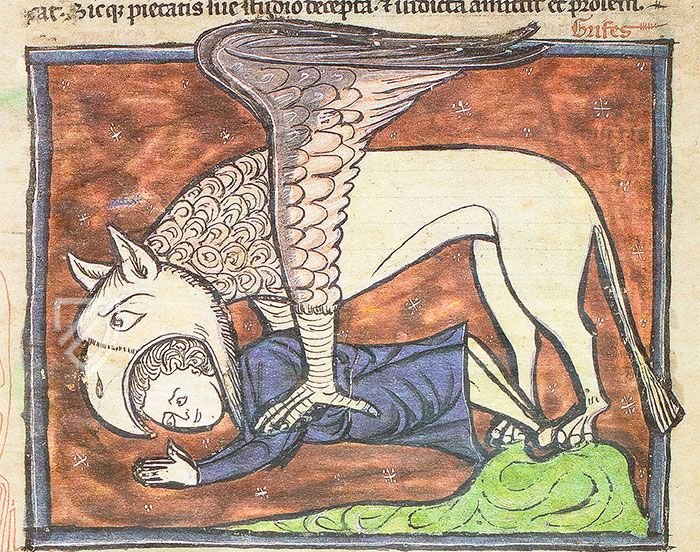
Westminster Abbey Bestiary
War Elephant
One of the most iconic aspects of ancient warfare was the war elephant, and even though they were a novelty in medieval Europe – Charlemagne had a pet elephant named Abul-Abbas – this remained the popular image of them. Medieval bestiaries usually depicted elephants in battle and often with a howdah or turret on its back. In this case, the howdah is depicted as a castle.
Both the elephant and the half-dozen soldiers fighting from the howdah/castle on its back have oddly serene looks on their faces. The massive size of the animal is wonderfully conveyed by this miniature, which exceeds its own borders on three sides as though it is marching out onto the page. This wonderful image details both the elephant’s wrinkly skin and the soldiers’ chainmail.

#1 Bestiario de Westminster
Languages: English, Spanish
(3,000€ - 7,000€)
- Treatises / Secular Books
- Apocalypses / Beatus
- Astronomy / Astrology
- Bestiaries
- Bibles / Gospels
- Chronicles / History / Law
- Geography / Maps
- Saints' Lives
- Islam / Oriental
- Judaism / Hebrew
- Single Leaf Collections
- Leonardo da Vinci
- Literature / Poetry
- Liturgical Manuscripts
- Medicine / Botany / Alchemy
- Music
- Mythology / Prophecies
- Psalters
- Other Religious Books
- Games / Hunting
- Private Devotion Books
- Other Genres
- Afghanistan
- Armenia
- Austria
- Belgium
- Colombia
- Croatia
- Cyprus
- Czech Republic
- Denmark
- Egypt
- Ethiopia
- France
- Germany
- Greece
- Hungary
- India
- Iran
- Iraq
- Israel
- Italy
- Japan
- Lebanon
- Luxembourg
- Mexico
- Morocco
- Netherlands
- Palestine
- Peru
- Poland
- Portugal
- Russia
- Serbia
- Spain
- Sri Lanka
- Sweden
- Switzerland
- Syria
- Turkey
- Ukraine
- United Kingdom
- United States
- Uzbekistan
- Aboca Museum
- Ajuntament de Valencia
- Akademie Verlag
- Akademische Druck- u. Verlagsanstalt (ADEVA)
- Aldo Ausilio Editore - Bottega d’Erasmo
- Alecto Historical Editions
- Alkuin Verlag
- Almqvist & Wiksell
- Amilcare Pizzi
- Andreas & Andreas Verlagsbuchhandlung
- Archa 90
- Archiv Verlag
- Archivi Edizioni
- Arnold Verlag
- ARS
- Ars Magna
- ArtCodex
- AyN Ediciones
- Azimuth Editions
- Badenia Verlag
- Bärenreiter-Verlag
- Belser Verlag
- Belser Verlag / WK Wertkontor
- Benziger Verlag
- Bernardinum Wydawnictwo
- BiblioGemma
- Biblioteca Apostolica Vaticana (Vaticanstadt, Vaticanstadt)
- Bibliotheca Palatina Faksimile Verlag
- Bibliotheca Rara
- Boydell & Brewer
- Bramante Edizioni
- Bredius Genootschap
- Brepols Publishers
- British Library
- C. Weckesser
- Caixa Catalunya
- Canesi
- CAPSA, Ars Scriptoria
- Caratzas Brothers, Publishers
- Carus Verlag
- Casamassima Libri
- Chavane Verlag
- Christian Brandstätter Verlag
- Circulo Cientifico
- Club Bibliófilo Versol
- Club du Livre
- CM Editores
- Collegium Graphicum
- Collezione Apocrifa Da Vinci
- Comissão Nacional para as Comemorações dos Descobrimentos Portugueses
- Coron Verlag
- Corvina
- CTHS
- D. S. Brewer
- Damon
- De Agostini/UTET
- De Nederlandsche Boekhandel
- De Schutter
- Deuschle & Stemmle
- Deutscher Verlag für Kunstwissenschaft
- DIAMM
- Droz
- E. Schreiber Graphische Kunstanstalten
- Ediciones Boreal
- Ediciones Grial
- Ediclube
- Edições Inapa
- Edilan
- Editalia
- Edition Deuschle
- Edition Georg Popp
- Edition Leipzig
- Edition Libri Illustri
- Editiones Reales Sitios S. L.
- Éditions de l'Oiseau Lyre
- Editions Medicina Rara
- Editorial Casariego
- Editorial Mintzoa
- Editrice Antenore
- Editrice Velar
- Edizioni Edison
- Egeria, S.L.
- Eikon Editores
- Electa
- Emery Walker Limited
- Enciclopèdia Catalana
- Eos-Verlag
- Ephesus Publishing
- Ernst Battenberg
- Eugrammia Press
- Extraordinary Editions
- Fackelverlag
- Facsimila Art & Edition
- Facsimile Editions Ltd.
- Facsimilia Art & Edition Ebert KG
- Faksimile Verlag
- Feuermann Verlag
- Folger Shakespeare Library
- Franco Cosimo Panini Editore
- Friedrich Wittig Verlag
- Fundación Hullera Vasco-Leonesa
- G. Braziller
- Gabriele Mazzotta Editore
- Gebr. Mann Verlag
- Gesellschaft für graphische Industrie
- Getty Research Institute
- Giovanni Domenico de Rossi
- Giunti Editore
- Graffiti
- Grafica European Center of Fine Arts
- Guido Pressler
- Guillermo Blazquez
- Gustav Kiepenheuer
- H. N. Abrams
- Harrassowitz
- Helikon
- Hendrickson Publishers
- Henning Oppermann
- Herder Verlag
- Hes & De Graaf Publishers
- Hoepli
- Holbein-Verlag
- Hortus Deliciarum
- Houghton Library
- Hugo Schmidt Verlag
- Idion Verlag
- Il Bulino, edizioni d'arte
- ILte
- Imago
- Insel Verlag
- Instituto Nacional de Antropología e Historia
- Istituto dell'Enciclopedia Italiana - Treccani
- Istituto Ellenico di Studi Bizantini e Postbizantini
- Istituto Geografico De Agostini
- Istituto Poligrafico e Zecca dello Stato
- Italarte Art Establishments
- J. Thorbecke
- Jan Thorbecke Verlag
- Johnson Reprint Corporation
- Josef Stocker
- Josef Stocker-Schmid
- Jugoslavija
- Karl W. Hiersemann
- Kasper Straube
- Kaydeda Ediciones
- Kindler Verlag / Coron Verlag
- Kodansha International Ltd.
- Konrad Kölbl Verlag
- Kurt Wolff Verlag
- La Liberia dello Stato
- La Linea Editrice
- La Meta Editore
- Lambert Schneider
- Landeskreditbank Baden-Württemberg
- Leo S. Olschki
- Les Incunables
- Library of Congress
- Libreria Musicale Italiana
- Lichtdruck
- Lito Immagine Editore
- Lumen Artis
- Lund Humphries
- M. Moleiro Editor
- Maison des Sciences de l'homme et de la société de Poitiers
- Manuscriptum
- Martinus Nijhoff
- Maruzen-Yushodo Co. Ltd.
- MASA
- McGraw-Hill
- Militos
- Millennium Liber
- Müller & Schindler
- Nahar and Steimatzky
- National Library of Wales
- Neri Pozza
- Nova Charta
- Oceanum Verlag
- Odeon
- Orbis Mediaevalis
- Orbis Pictus
- Österreichische Staatsdruckerei
- Oxford University Press
- Pageant Books
- Parzellers Buchverlag
- Patrimonio Ediciones
- Pattloch Verlag
- PIAF
- Pieper Verlag
- Plon-Nourrit et cie
- Prestel Verlag
- Princeton University Press
- Prisma Verlag
- Priuli & Verlucca, editori
- Pro Sport Verlag
- Propyläen Verlag
- Pytheas Books
- Quaternio Verlag Luzern
- Reales Sitios
- Recht-Verlag
- Reichert Verlag
- Reichsdruckerei
- Riehn & Reusch
- Roberto Vattori Editore
- Rosenkilde and Bagger
- Roxburghe Club
- Salerno Editrice
- Sarajevo Svjetlost
- Schöck ArtPrint Kft.
- Scolar Press
- Scrinium
- Scripta Maneant
- Scriptorium
- Siloé, arte y bibliofilia
- SISMEL - Edizioni del Galluzzo
- Sociedad Mexicana de Antropología
- Société des Bibliophiles & Iconophiles de Belgique
- Soncin Publishing
- Sorli Ediciones
- Stainer and Bell
- Studer
- Styria Verlag
- Sumptibus Pragopress
- Szegedi Tudomànyegyetem
- Taberna Libraria
- Tarshish Books
- Taschen
- Tempus Libri
- Testimonio Compañía Editorial
- Thames and Hudson
- The Clear Vue Publishing Partnership Limited
- The Facsimile Codex
- The Folio Society
- The Marquess of Normanby
- The Richard III and Yorkist History Trust
- Tip.Le.Co
- TouchArt
- TREC Publishing House
- TRI Publishing Co.
- Trident Editore
- Typis Regiae Officinae Polygraphicae
- Union Verlag Berlin
- Universidad de Granada
- University of California Press
- University of Chicago Press
- Urs Graf
- Vallecchi
- Van Wijnen
- VCH, Acta Humaniora
- VDI Verlag
- VEB Deutscher Verlag für Musik
- Verlag Anton Pustet / Andreas Verlag
- Verlag Bibliophile Drucke Josef Stocker
- Verlag der Münchner Drucke
- Verlag für Regionalgeschichte
- Verlag Styria
- Vicent Garcia Editores
- W. Turnowsky
- Waanders Printers
- Wiener Mechitharisten-Congregation (Wien, Österreich)
- Wissenschaftliche Buchgesellschaft
- Wydawnictwo Dolnoslaskie
- Xuntanza Editorial
- Zakład Narodowy
- Zollikofer AG

